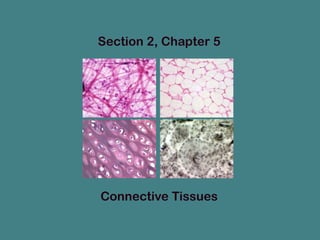
Section 2,chapter 5
- 1. Section 2, Chapter 5 Connective Tissues
- 2. Characteristics of Connective Tissues (CT) Cells are separated by non-cellular material, called the extracellular matrix Most connective tissues have good blood supply Most cells divide (to recover from injury) Elastic Cartilage Extracellular matrix nucleus of cell
- 3. Cell Types Cells of CT may either be fixed in place (resident cells) or they may be wandering cells Examples of fixed cells Fibroblasts Secretes protein fibers into matrix Fibroblast Mast Cells Secretes histamine & heparin into blood Mast Cell
- 4. Wandering cells move throughout the tissues. Example of a wandering cell: Macrophages Macrophages actively move about during infection phagocytizing bacteria & debris. macrophages
- 5. extracellular matrix of connective tissues The matrix of most CT contains protein fibers & a non-protein ground substance Protein Fibers Protein fibers are secreted by fibroblasts. 3 types of protein fibers include elastic fibers, collagen fibers, and reticular fibers
- 6. Protein Fibers 1. Collagenous fibers Thick bands of protein Collagen fibers are flexible, but only slightly elastic They exhibit great tensile strength that resists pulling Collagenous fibers forms the bulk of ligaments & tendons Most abundant protein in mammals Ligaments connect bone to bone Tendons connect muscle to bone
- 7. Protein Fibers 2. Elastic Fibers Composed of a spring-like protein, called elastin. Elastic fibers are weaker than collagen, but exhibit elastic recoil Elastic fibers can be easily stretched or deformed and they retain their shape. Locations: vocal cords, respiratory tract, blood vessels
- 8. Figure 5.17 Scanning electron micrograph of collagenous fibers and elastic fibers
- 9. Protein Fibers 3. Reticular Fibers Consist of thin strands of collagen fibers Reticular fibers form an interwoven matrix, called a reticulum. Reticular fibers fill the spleen, liver, and lymph nodes Reticular fiber
- 10. Types of connective tissue Connective tissue is often divided into two categories 1. CT proper 2. Specialized CT Connective Tissue Proper Loose Connective Tissue Areolar Adipose Reticular Specialized Connective Tissue Cartilage Bone Blood Dense Connective Tissue Dense Regular C.T. Dense Irregular C.T. Elastic C.T.
- 11. Areolar Tissue Areolar tissue consist of a loose network of collagen and elastic fibers produced by fibroblasts. Areolar tissue forms delicate membranes that loosely bind organs together Locations subcutaneous layer of skin between muscles surrounds organs Functions anchors skin to underlying organs holds organs in place
- 12. Adipose Tissue (fat) Structure Precursor cells resemble fibroblasts, but as they accumulate fat droplets in the cytoplasm they become adipocytes. Functions of adipose stores energy insulation cushions organs secretes estrogens Locations Beneath the skin – subcutaneous fat Within abdominal cavity – visceral fat Surrounds kidneys & eyeballs Surface of heart
- 13. Reticular Connective Tissue Structure Reticular CT contains fibroblasts along with a network of thin collagenous fibers arranged into a reticulum. Locations include the framework of Spleen Liver Lymph nodes Functions of reticular CT forms the framework of some organs reduces the flow of fluid through an organ
- 14. Dense Regular Connective Tissue Structure: Dense Regular CT contains relatively few fibroblasts with densely packed collagenous fibers in parallel arrangement. Functions: Great tensile strength that withstands pulling forces especially in one direction Locations: Tendons & Ligaments Dense CT has a poor blood supply so they are slow to heal following an injury.
- 15. Dense Irregular Connective Tissue Structure Dense Irregular CT contains fibroblasts with a dense network of interwoven collagenous fibers Functions Dense Irregular CT withstands pulling forces in all directions Location Dermis of skin Dermis (deep layer) of skin
- 16. Elastic Connective Tissue Structure Elastic CT contains fibroblasts along with a dense arrangement of elastic fibers, with a few collagen fibers. Functions Elastic recoil Locations Walls of larger arteries and the respiratory tract
- 17. Cartilage Overview Functions of cartilages Provides attachments Protects tissue Structural model for developing bone General structure of cartilages Mature cartilage cells are called chondrocytes The extracellular matrix of cartilage consists of 1. An abundance of collagen fibers 2. a gel-like ground substance 3. Lacunae = cavities containing chondrocytes In addition, each of the three types of cartilages have unique characteristics.
- 18. Hyaline Cartilage Structure Hyaline cartilage contains very fine collagenous fibers and the ground substance gives hyaline cartilage a glossy appearance. Functions Hyaline cartilage provides durable protection and supports movable joints Locations end of bones embryonic skeleton costal cartilages of the ribs end of the nose
- 19. Elastic Cartilage Structure Elastic cartilage contains a dense network of elastic fibers in its extracellular matrix in addition to the gel-like ground substance and collagen proteins. Function Elastic cartilage provides flexible support that helps maintain the shape of the organs. Locations framework of external ear and portions of the larynx
- 20. Fibrocartilage Structure Hyaline cartilage contains very fine collagenous fibers and the ground substance gives hyaline cartilage a glossy appearance. Function Fibrocartilage acts like a shock absorber Locations within intervertebral discs meniscus of the knees pubic symphysis
- 21. Bone Structure Bone is composed of 1. Cells called osteocytes within lacunae (cavities) 2. Collagen fibers that offer pliability to bone 3. Mineral Salts that provide hardness Functions 1. support and protection 2. movement 3. blood cell production Locations skeleton of the body
- 22. Blood Structure Blood is composed of red blood cells, white blood cells, and platelets suspended in a fluid matrix, called plasma. Functions 1. RBCs – transport gasses 2. WBCs – fight infection and remove debris 3. Platelets – blood coagulation (clotting) 4. Plasma – transports nutrients, wastes, hormones, etc. Location Within blood vessels
- 23. Overview of Connective Tissues End Section 2, Chapter 5